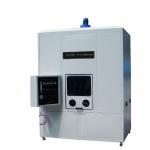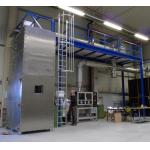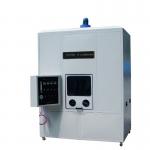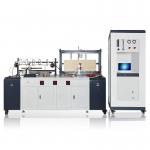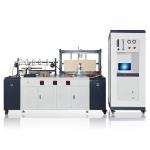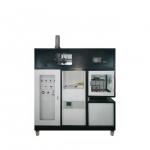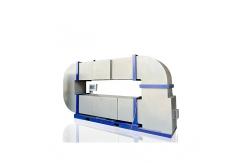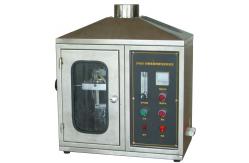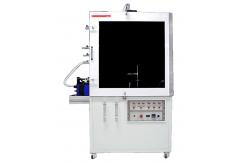In the dynamic and safety-conscious construction industry, the
evaluation of building materials' fire performance is a cornerstone
of ensuring the integrity and security of structures. The
Customized Fire Evaluation Equipment for Building Materials Testing
emerges as a sophisticated and indispensable tool, designed to meet
the exacting demands of architects, engineers, builders, and
regulatory authorities. This state-of-the-art Customized Fire Evaluation Equipment is
specifically engineered to conduct comprehensive and accurate
assessments of the fire-related properties of a vast array of
building materials. From traditional bricks and mortar to modern
insulation materials, composites, and fireproof coatings, it serves
as a reliable ally in the quest for safer construction. The
overarching goal is to determine crucial parameters such as
ignition temperature, flame spread rate, heat release rate, smoke
production and toxicity, and the ability of materials to maintain
structural integrity under the duress of fire. This data is not
only essential for adhering to stringent building codes and
regulations but also for inspiring innovation in the development of
novel, more fire-resistant building materials. - Sturdy and Heat-Resistant Construction
- The equipment is built with a rugged framework, typically crafted
from high-strength alloy steel, which can withstand the extreme
temperatures and mechanical forces associated with fire testing.
The interior testing chamber is lined with advanced refractory
ceramics or high-temperature insulation materials, capable of
withstanding temperatures up to 2000°C. The access doors and
viewing ports are constructed with multiple layers of
heat-strengthened glass and hermetic seals, ensuring a controlled
and safe testing environment. A robust heat-resistant enclosure
safeguards the surrounding area and operators from the intense heat
and potential hazards of the testing process.
- Precision Temperature and Flame Control Mechanisms
- Temperature Control: The equipment offers unparalleled precision in
temperature regulation, spanning from ambient temperature to
1600°C, with an accuracy of ±1°C. It employs a combination of
high-efficiency heating elements, such as silicon carbide or
molybdenum disilicide heaters, and a sophisticated PID
(Proportional-Integral-Derivative) control algorithm. Multiple
thermocouples are strategically positioned throughout the chamber
to ensure uniform temperature distribution and rapid response to
any temperature fluctuations. The user-friendly control panel
allows for the programming of intricate temperature profiles,
including ramping, holding, and cycling, to replicate a diverse
range of real-world fire scenarios and temperature gradients.
- Flame Generation and Control: The flame system is highly adaptable
and customizable. It can produce flames with adjustable
intensities, from a gentle pilot flame for delicate testing to a
powerful, turbulent flame for simulating severe fire conditions.
The fuel supply, which can accommodate various combustible gases
such as propane, methane, or butane, is precisely metered using
ultra-precise flow regulators. The air-fuel ratio can be adjusted
within a wide range, typically from 1:1 to 20:1, enabling the
creation of flames with different combustion characteristics. This
flexibility is crucial for evaluating the response of building
materials to different types of flames, such as the slow-burning,
smoldering flames associated with the initial stages of a fire or
the intense, high-temperature flames characteristic of a fully
developed blaze.
- Advanced Instrumentation and High-Speed Data Acquisition
- The Customized Fire Evaluation Equipment is equipped with a
comprehensive suite of sensors and measurement devices. In addition
to highly accurate temperature and flame sensors, it incorporates
optical sensors for detailed monitoring of flame characteristics,
including flame height, luminosity, color temperature, and spectral
analysis. Smoke density sensors, based on advanced light scattering
or absorption technologies, can accurately measure the
concentration and particle size distribution of smoke. Gas sensors
are designed to detect and analyze the composition of gases emitted
during combustion, such as carbon monoxide, carbon dioxide,
volatile organic compounds, and toxic gases like hydrogen cyanide.
These sensors are interfaced with a high-speed, multi-channel data
acquisition system that records and stores all relevant data. The
data acquisition system offers an impressive sampling rate, often
exceeding 12,000 samples per second, ensuring that even the most
rapid and minute changes in fire behavior are faithfully captured.
The collected data can be analyzed in real-time or retrieved later
for in-depth studies using specialized software, which provides
detailed reports and graphical representations of the test results,
facilitating comprehensive data interpretation and analysis.
- Versatile Testing Modes and Configurations
- The equipment offers a wide variety of testing modes and
configurations tailored to the specific needs of building materials
testing. It can perform horizontal and vertical flame spread tests
on materials such as wallboards, flooring, and roofing materials,
providing valuable insights into how fire would propagate across
different surfaces. Cone calorimeter tests can be carried out to
measure the heat release rate and other combustion parameters of
samples under a controlled radiant heat flux, which is essential
for understanding the fire behavior of insulation and other
combustible building components. Additionally, it can conduct fire
resistance tests on structural elements like columns, beams, and
walls, evaluating their ability to maintain load-bearing capacity
and integrity during a fire. The equipment can also be integrated
with other environmental control systems, such as humidity and
pressure control, to study the combined effects of multiple factors
on fire performance. This versatility makes it suitable for testing
a vast range of building materials, from traditional building
materials like concrete, steel, wood, and insulation to advanced
industrial materials such as polymers, composites, and high-tech
coatings.
- Stringent Compliance with Building Fire Safety Standards
- The Customized Fire Evaluation Equipment is meticulously designed
to comply with a comprehensive set of international and national
building fire safety standards. It adheres to ASTM (American
Society for Testing and Materials) standards, such as ASTM E84 for
surface burning characteristics, ASTM E1354 for heat and visible
smoke release rates, and ASTM E662 for smoke density. It also meets
ISO (International Organization for Standardization) standards,
including ISO 5660 for reaction-to-fire tests and ISO 1716 for
calorific value determination. This strict compliance ensures that
the test results obtained using this equipment are widely
recognized and accepted by building regulatory bodies and industry
peers, facilitating seamless product certification and market
access.
- Chamber Size and Capacity
- The equipment is available in different chamber sizes to
accommodate the diverse range of building material samples and
testing requirements. Smaller chambers may have interior dimensions
of 0.4 meters x 0.4 meters x 0.4 meters, suitable for testing small
specimens like samples of fireproof coatings or individual pieces
of insulation. Medium-sized chambers can measure 0.8 meters x 0.8
meters x 0.8 meters, providing sufficient space for testing larger
building materials or a batch of similar components. Larger
chambers, with dimensions exceeding 1.5 meters x 1.5 meters x 1.5
meters, are ideal for full-scale testing of structural elements or
assemblies. The interior volume and shape are carefully optimized
to ensure proper air circulation and uniform exposure of the sample
to the fire and environmental conditions.
- Temperature Range and Accuracy
- As mentioned earlier, the temperature can be controlled from
ambient to 1600°C, with an accuracy of ±1°C. The temperature ramp
rate can be adjusted from 0.5°C per minute to 150°C per minute,
allowing for the simulation of both slow and rapid temperature
changes. For example, a slow ramp rate may be used to study the
thermal degradation of a building material over time, while a rapid
ramp rate can mimic the sudden heat increase during a fire
outbreak.
- Flame Intensity and Control Parameters
- The flame intensity can be adjusted over a wide spectrum, with a
maximum heat output equivalent to several megawatts per square
meter. The fuel flow rate can be varied from a few milliliters per
minute to several liters per minute, and the air-fuel ratio can be
precisely controlled within a range of 1:1 to 20:1. These
parameters enable the creation of flames with different
characteristics, from a small, stable flame for precision testing
to a large, turbulent flame for more severe fire simulations.
- Data Acquisition Rate and Resolution
- The data acquisition system samples sensor data at a rate of 12,000
samples per second. The temperature sensor has a resolution of
0.1°C, the smoke density sensor can detect changes as small as
0.005% opacity, and the gas sensors have a sensitivity in the parts
per million (ppm) range for most common gases. This high-resolution
and high-speed data capture ensure that the equipment provides
detailed and accurate information about the fire performance of the
tested building materials.
- Compliance with Key Building Fire Testing Standards
- The equipment complies with ASTM E84, ASTM E1354, ASTM E662, ISO
5660, and ISO 1716, among other relevant standards. It can also be
customized to meet specific requirements of other industry
standards or regulatory codes, ensuring its adaptability to
different construction applications and local building regulations.
- Accurate and Comprehensive Fire Performance Evaluation
- The primary function of the equipment is to provide a highly
accurate and realistic simulation of fire conditions for building
materials. By precisely controlling temperature, flame
characteristics, and other environmental factors, it allows for the
in-depth assessment of how materials will behave in an actual
building fire. For example, it can determine if a particular
insulation material will contribute to the spread of fire, if a
steel structure will maintain its strength under high temperatures,
or if a fireproof coating will effectively reduce the flammability
of a substrate. This information is invaluable for architects and
engineers to make informed decisions and select the most suitable
materials for constructing safer buildings.
- Enhanced Building Design and Material Selection
- Through detailed fire performance testing, construction
professionals can make well-informed decisions about material
selection and building design. If a material shows a high flame
spread rate or excessive smoke and toxic gas production,
alternative materials can be considered. For instance, if a wooden
panel has a poor fire performance, a fire-retardant-treated version
or a non-combustible substitute can be chosen. This leads to the
development of more fire-resistant building designs, reducing the
risk of fire damage and ensuring the safety of occupants.
- Facilitation of Regulatory Compliance and Building Certification
- Building regulatory bodies rely on accurate and standardized fire
performance test results to enforce building fire safety
regulations. The Customized Fire Evaluation Equipment enables
construction material manufacturers and builders to conduct tests
in accordance with recognized industry standards, providing the
necessary data for regulatory compliance and building
certification. This helps in streamlining the approval process,
ensuring that buildings are constructed with fire-safe materials
and meet the required safety standards.
- Stringent Manufacturing Process
- The fire evaluation equipment for building materials is
manufactured under strict quality control procedures. Each
component, from the heating elements and sensors to the control
panel and chamber lining, is carefully sourced and inspected for
quality and performance. The assembly process is carried out by
highly trained technicians in a clean and controlled environment.
The equipment undergoes a series of calibration and validation
tests during the manufacturing process to ensure that it meets the
required accuracy and performance standards.
- The calibration of temperature, flame, and other sensors is a
critical part of the manufacturing process. It is performed using
traceable reference standards that are calibrated to the highest
levels of accuracy, guaranteeing the reproducibility of the test
results. Rigorous quality audits and inspections are conducted at
various stages of production to maintain the highest level of
product quality and compliance with building fire performance
testing standards.
- Quality Certification and Validation
Our equipment has obtained relevant quality certifications and has
been validated by independent building fire testing laboratories.
It has been proven to provide accurate and reliable test results,
conforming to the relevant industry standards. We also continuously
update and improve our product based on the latest technological
advancements and customer feedback from the construction and fire
safety industry to ensure its long-term performance and compliance.
- Testing of Building Insulation Materials
- A leading insulation material manufacturer used the Customized Fire
Evaluation Equipment to test a new type of foam insulation. The
tests revealed that the material had a relatively high heat release
rate and significant smoke production. By reformulating the
material and adding fire retardants, they were able to reduce the
heat release rate by 50% and minimize smoke production, making it a
more suitable option for building insulation and meeting the
required fire safety standards.
- Evaluation of Fireproof Coatings for Steel Structures
- A construction company tested different fireproof coatings on steel
beams using the equipment. The results showed that one particular
coating was able to increase the fire resistance of the steel beams
by an additional 30 minutes compared to a standard coating. This
led to the company specifying this coating for a high-rise building
project, enhancing the overall fire safety of the structure.
- Assessment of Structural Elements like Columns and Walls
- A research institution used the equipment to study the fire
performance of new composite columns. The detailed data obtained
from the tests enabled them to optimize the design and composition
of the columns, ensuring that they could maintain their
load-bearing capacity for a longer period during a fire. This
research led to the development of more fire-resistant structural
elements that could be used in modern building construction.
- Pre-Sales Technical Consultation
Our team of building fire safety experts provides in-depth
technical consultations to help customers understand the
capabilities and suitability of the Customized Fire Evaluation
Equipment for their specific construction testing needs. We offer
demonstrations and training, tailored to the construction industry,
to familiarize customers with the operation and functionality of
the equipment before purchase. We also assist in selecting the
appropriate test methods and accessories based on the materials or
structures to be tested. - After-Sales Service and Maintenance
We offer comprehensive after-sales service, including on-site
installation and commissioning. Our technicians are available for
regular maintenance, calibration, and emergency repairs. We provide
spare parts and upgrades to keep the test equipment operating at
peak performance. We also offer service contracts that include
preventive maintenance and priority technical support, ensuring the
long-term reliability and availability of the equipment for fire
evaluation testing in the construction industry. - Training and Technical Support
We conduct training programs for new users to ensure they can
effectively operate the Customized Fire Evaluation Equipment and
interpret the test results. Our technical support team is available
24/7 to answer questions, provide troubleshooting assistance, and
offer guidance on test method optimization and compliance with
building fire performance testing standards. We also provide
software updates and support for the data acquisition and analysis
systems, enabling customers to take full advantage of the latest
features and technologies in fire evaluation testing for the
construction sector.
The Customized Fire Evaluation Equipment for Building Materials
Testing is an essential asset for any organization involved in
building design, construction, and fire safety. If you are looking
to enhance your fire evaluation testing capabilities, ensure
compliance with building standards, or drive innovation in building
fir |
